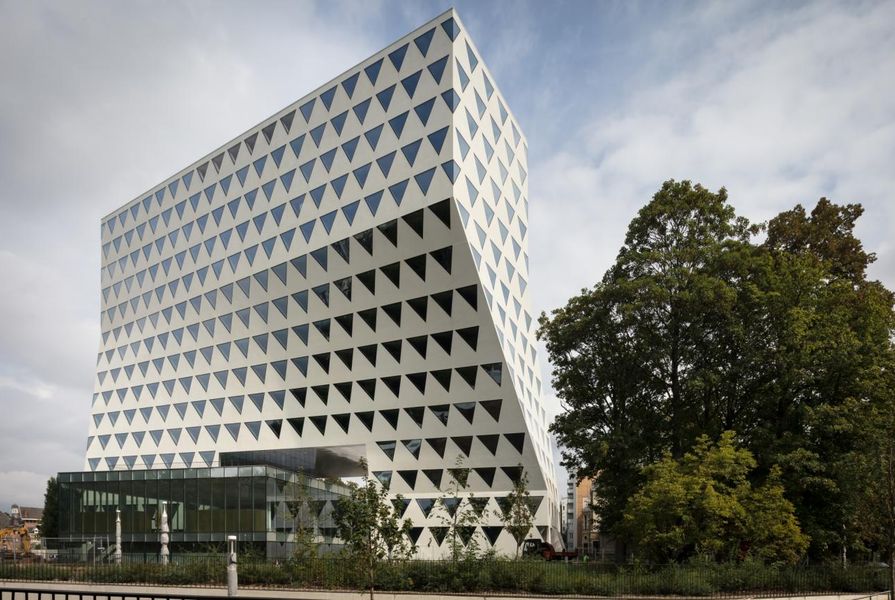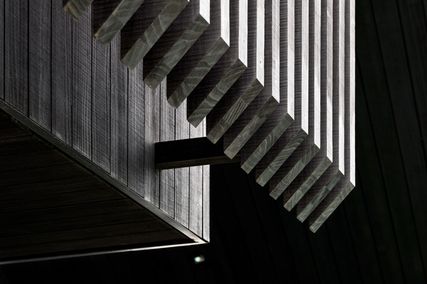The office of the Flemish Government Architect (Vlaams Bouwmeester) is charged with promoting architectural quality across the northern half of Belgium. Erik Wieërs is the sixth architect to hold the position. He spoke with Susan Holden about his role and the Open Call procurement method that has been integral to the transformation of public building culture in Belgium.1
Susan Holden: The establishment of the Flemish Government Architect parallels the re-establishment in Australia of the state and territory government architect positions in their current advisory mode. Can you tell me a bit more about your role?
Erik Wieërs: The Vlaams Bouwmeester started in 1999. Flanders was the first region in Belgium to establish a [government architect] role. We advise the Flemish Government and public authorities. Any part of government can come to us for advice. My position is a fixed five-year term. As part of the appointment process, each candidate produces a five-year plan of what you would do as Government Architect. So, an important part of my role is to bring this vision and agenda.
Erik Wieërs, the sixth architect to hold the position of Flemish Government Architect.
Image: supplied
There are 16 people in my team as we speak, including architects, urbanists, and designers with other specializations such as landscape architects. We also have team members who specialize in making presentations and publications. Those communication roles are very important. My team all have ongoing contracts, so they will continue after my term finishes. Some of them have worked for the Vlaams Bouwmeester for many years – we have a lot of accumulated experience in the office.
The office has an annual budget of about €480, 000 [approx. $750,000]. We use this to, for instance, pay for consultancies and experts to sit on juries. We also seek funding from other agencies or ministries for specific projects. The Department for Environment and Spatial Development subsidizes some long-term regional investigations on water, energy, sustainable mobility and other topics. We are always trying to make connections with others in government. A Flemish expression that describes how we try to bring everyone who is a stakeholder into the design process translates to “bringing everyone into the bathtub.”
SH: You were appointed Flemish Government Architect in 2020. Had this career move been on your radar?
EW: I had my own office in Antwerp, Collectief Noord Architecten. We did a lot of social housing projects. I had also been teaching architectural design at the University of Antwerp for more than 20 years. Around 2000, I was asked to be on the Quality Commission for the City of Antwerp, and I developed an interest in contributing to the quality of architecture outside of the activity of design itself – for example, through policy. Through this work, I also made contacts in government. I was approached to consider applying for the Vlaams Bouwmeester role. The three younger associates in my office were looking to take more responsibility, so it felt like a good time in my own life to pursue this path.
SH: In Australia, one of the challenges for state and territory government architects, as they become more entrenched in the organizational structures of government, is being able to give frank and fearless advice. Do you face a similar challenge in your role? How do you manage it?
EW: It is very important to be independent. I have the feeling that I am, that I can speak freely. I can do this in some respects because, at the time of my appointment, my five-year plan received some level of endorsement from the ministers. They don’t necessarily agree with every detail or commit to it all, but they didn’t seek to censor it. I think after 20 years they know that allowing a Government Architect some freedom of speech is less dangerous than trying to shut them down. But I’m also careful in the way I speak. It’s not my job to criticize politicians.
SH: The Open Call – a procurement method developed by the Vlaams Bouwmeester – is one of the key tools of your office. Somewhere between a competition framework and a design governance policy instrument,2 it appoints designers for public commissions involving architecture, urbanism, landscape design, public space and infrastructure. Can you explain the Open Call and what you see as its strengths and successes?
School Extension Rumst by Bovenbouw from Open Call 1219.
Image: Filip Dujardin
EW: One of the most important points to make is that the Open Call aims to choose an architect, not a building. It is very much a process, and one of the main aims of the process is to help commissioning authorities to build good relationships with their architects. We believe this is the basis of a good outcome.
SH: So, this establishes a basis for the co-production of the project?
EW: As Bob Van Reeth, the first Flemish Government Architect, said, it’s not enough to appoint a good designer. You need a clear and ambitious question to motivate designers. The Open Call procedure helps commissioning agencies to develop an ambitious project brief; to be clear about what they want, not only for their own needs, but also to see their project as making a public contribution.
SH: And how does the process unfold?
EW: An Open Call is launched twice a year. Different project commissions are announced at the same time, so there is certainty about the timeframes and process, and architects can see the different opportunities and decide whether they want to apply. It could be a project in a city or a small village; a building, a park or a masterplan. Architects in all of Europe can apply.
The Vlaams Bouwmeester team then makes a shortlist for each project together with the commissioning authority. We aim at a shortlist that is diverse and will provide the commissioning authority with different options. Designers don’t need to submit references of similar projects. It can be interesting to invite a young ambitious architect who has never done that type of building before, who may come up with new ideas. All the candidates taking part in the competition get fair remuneration for their competition work.
We run two briefing sessions with the shortlisted participants, together with the commissioning agency. All the architects can ask questions and everyone benefits from this open dialogue. The candidates subsequently present their draft design to a jury that includes the commissioning authority, some external experts (often academics), a member of my team and myself. The presentation is very much about the concept, not a finished design. The commissioning authority has a chance to think about whether this is the architect with whom they will be able to make a good building. The jury helps them ask the right questions. This moment allows for a genuine discussion about architecture.
Water Tower in Beersel by Bel Architecten from Open Call 1406.
Image: Niels Donckers
SH: It makes me think of the way building culture or baukultur is being taken up as a policy topic more broadly in Europe.3 There is growing interest in planning approaches that foster design excellence in Australia too. But one of the challenges here is an adversarial planning system in which the private sector has a lot of control over development. And there are not so many opportunities for public building commissions. As a model, do you think the Open Call can influence the way things are done in other parts of government, or even the development industry more broadly?
EW: In 20 years, we have done more than 700 Open Calls that have delivered over 300 built projects. But it is not mandatory in Flanders that public authorities work with the Government Architect. Authorities come to us of their own initiative.
It means we work with very motivated clients – but even then, we sometimes experience frustration at arriving too late in the process, when some spatial decisions have already been made. How to be able to exert influence at the right time – that remains a bit of a challenge. It’s very interesting to see some local governments looking to have more of an influence at the point of the property transaction.
But the Open Call has been an exemplary process for how to do an architectural competition. Other organizations have certainly learnt from it: for example, social housing companies and aged-care organizations in Belgium. The Brussels region now also has a Government Architect. There is a policy in this region that for buildings over 5,000 square metres, you need approval that includes engaging with the Government Architect. So [in the Brussels region], the Government Architect has some capacity to engage with the private sector.
SH: Some commentators have highlighted the Open Call as contributing to a cultural transformation in Belgian architecture that is helping to overcome the country’s reputation for ugliness.4 This is a trope that will resonate in Australia, as we’ve had our own historical commentary on the ugliness of Australia’s built environment.5 How was this transformation achieved in a relatively short time?
EW: There really has been a cultural change. Even at the local government level, at least somebody in the administration or involved in policy will be convinced that when you make a building, you have to be interested in architectural quality.
SH: The architectural quality of the Open Call projects is certainly very contextual and varied. I am struck by the programmatic variety and refinement among the education and care facility projects, and the assured subtlety of many of the infrastructure projects.
EW: These 300 buildings are each, from an architectural point of view, very successful. By writing a good brief and selecting diverse candidates, the process has helped to make a sophisticated commissioning culture. We also maintain an archive of all the Open Calls. It’s a huge amount of information that is accessible on our website.6
SH: I imagine there is a lot of design intelligence in that archive that has value beyond simply being an historical record. So, what are you seeking for the next stage of evolution of the Vlaams Bouwmeester?
EW: We are discussing how to adapt the Open Call because, throughout the years, it’s become more legally complex. We want to simplify it again, but this is difficult within European law. Typical procurement models do not necessarily suit architecture. I’m very convinced that architecture is always contextual. It depends on the particular place and the particular project and demands a new narrative every time. Architectural culture also exists in this renewal of its program. So, this is very important for the advancement of architectural culture as well.
- Florian Heilmeyer (ed.), Celebrating Public Architecture: Buildings from the Open Call in Flanders 2000–21 (Berlin: Jovis, 2022).
- Maarten Liefooghe and Maarten Van Den Driessche, More Than a Competition: The Open Call in a Changing Building Culture (Antwerp: Flanders Architecture Institute and Team Vlaams Bouwmeester, 2021). A visitor’s guide to the exhibition “Open Call: 20 years of public architecture” summarizes the process and can be downloaded from vlaamsbouwmeester.be/nl/nieuws-publicaties/bezoekersgids-open-oproep-20-jaar-architectuur-publieke-opdracht.
- Swiss Confederation, Office fédéral de la culture, Davos Declaration 2018: Towards a High Quality Baukultur for Europe , 2018, davosdeclaration2018.ch/en/dd;nav/ index/davos-declaration.
- Oliver Wainwright, “The Flanders phenomenon: How Belgian buildings went from joke to genius,” The Guardian , 28 April 2022. Available at theguardian.com/artanddesign/2022/apr/28/flanders-phenomenon-belgian-buildings-joke-genius-greatest-public-architecture-earth-zaha-hadid.
- Robin Boyd, The Australian Ugliness (Melbourne: Cheshire, 1960). Janina Gosseye and Hilde Heynen, “In Search of the Ugliest Country in the World: Australia vs. Belgium: On Robin Boyd, Renaat Braem, Regionalism and Post-war Modernism,” in Alexandra Brown and Andrew Leach (eds), Proceedings of the Society of Architectural Historians, Australia and New Zealand: 30, Open , vol. 1, 2013, 419–431, sahanz.net/wp-content/uploads/S09_02_Gosseye-and-Heynen_In-Search-of-the-Ugliest.pdf.
- See vlaamsbouwmeester.be/en/instruments/open-call.






















